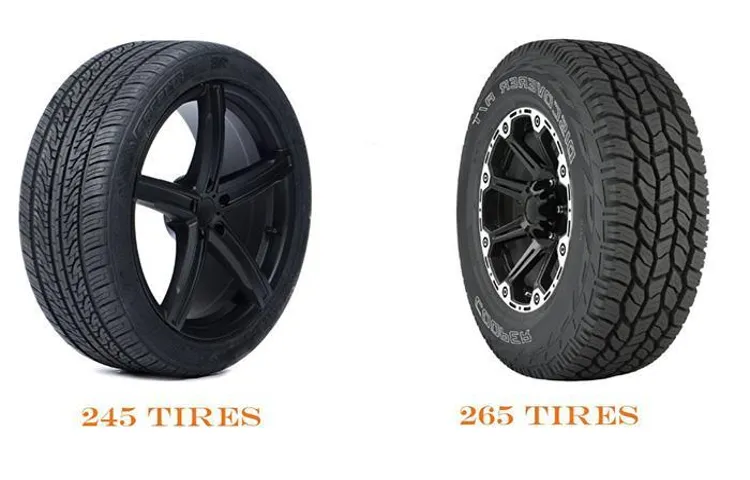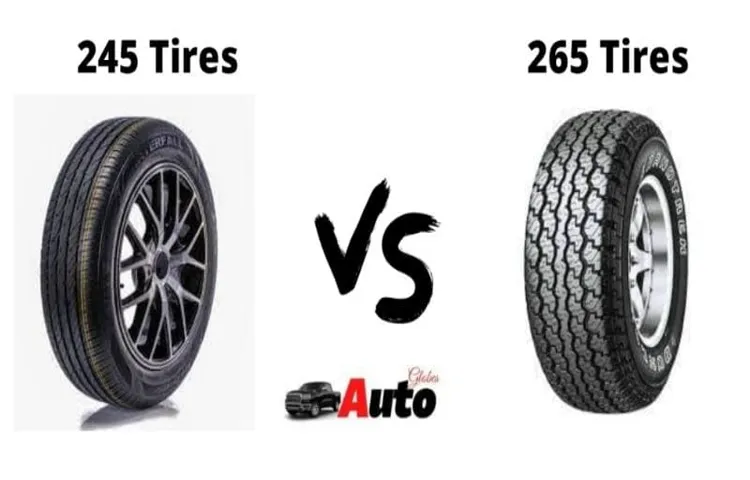Have you ever wondered about the difference between 265 and 245 tires? While the numbers might seem arbitrary at first glance, they actually refer to the width of the tire in millimeters. Understanding the difference between these two tire sizes can help you make an informed decision when it comes time to replace your tires or choose new ones for your vehicle. Essentially, a 265 tire is wider than a 245 tire, with a difference of 20 millimeters between the two sizes.
This might not seem like a significant difference, but it can have a noticeable impact on your driving experience. A wider tire generally provides better stability when making sharper turns, as well as improved traction and handling in wet or slippery driving conditions. On the other hand, a narrower tire like a 245 can offer better fuel efficiency and a smoother ride on long stretches of highway.
Additionally, narrower tires are typically less expensive, so it can be a more cost-effective option if you’re on a budget. Ultimately, the choice between 265 and 245 tires depends on your driving habits and priorities. If you prioritize handling and performance, a wider 265 tire might be the better choice for you.
However, if fuel efficiency and cost savings are your top concerns, a narrower 245 tire could be the way to go. In the end, no matter which tire size you choose, it’s important to make sure you select a quality tire from a reputable brand to ensure your safety and the longevity of your vehicle.
Table of Contents
Understanding Tire Sizes
When it comes to tire sizes, the numbers can be a bit confusing, especially when trying to compare two different sizes. So, how much bigger is a 265 tire than a 245? Well, the numbers represent the tire’s width in millimeters, with the first number being the width of the tire’s tread and the second number indicating the height of the sidewall given as a percentage of the tread width. In this case, a 265 tire would be 20 millimeters wider than a 245 tire.
While this may not seem like a significant difference, it can affect the tire’s performance and handling, as well as impact its compatibility with your vehicle. It’s important to consult with a professional or refer to your vehicle’s owner manual to ensure you are selecting the right tire size for your needs.
What do 265 and 245 tire sizes mean?
Tire sizes can be quite confusing, with a barrage of numbers and letters that don’t always make sense. However, understanding what these numbers mean can help you choose the right tires for your vehicle. The first number indicates the width of the tire in millimeters.
So a tire size of 265 means it is 265 millimeters wide from sidewall to sidewall. The second number refers to the aspect ratio, or the height of the sidewall as a percentage of the width. So a tire with a size of 265/70 would mean the height of the sidewall is 70% of the width of the tire.
This number is important because it affects the handling and performance of the tire. The last number is the diameter of the wheel the tire is meant to fit on, measured in inches. So a tire with the size 265/70R16 would mean it is 265 millimeters wide, the sidewall height is 70% of that width, and it is meant to fit on a 16-inch wheel.
Similarly, a tire with a size of 245/55R18 would mean it is 245 millimeters wide, has a sidewall height that is 55% of the width, and is meant to fit on an 18-inch wheel. Understanding tire sizes can help you choose the right tires for your vehicle and ensure optimal performance.

How are tire sizes measured?
Tire sizes are an essential element to consider when buying new tires. The measurements are defined by a series of numbers and letters. The first number represents the tire’s width in millimeters.
The next number is the aspect ratio, which is the height of the tire’s sidewall relative to its width, expressed as a percentage. The R stands for radial construction, and the final number indicates the rim diameter in inches. For example, a tire labeled P215/65R15 has a width of 215 millimeters, an aspect ratio of 65%, is a radial tire, and fits a 15-inch rim.
Understanding tire sizes can be critical when purchasing new tires to ensure the correct fit and function of your vehicle. Therefore, it is recommended that you consult the owner’s manual or a tire professional for the appropriate tire size for your vehicle.
Comparing 265 and 245 Tires
If you’re thinking of upgrading your vehicle’s tires, you may be wondering how much bigger a 265 tire is compared to a 245 tire. Well, the answer is pretty straightforward: a 265 tire is about 20 millimeters wider than a 245 tire. While this may not seem like a significant difference, it can have a noticeable impact on your driving experience.
A wider tire generally provides better traction and stability, which is especially important if you frequently drive on rough or slippery roads. However, it’s crucial to ensure that the larger tire size is compatible with your vehicle and won’t cause any interference with the fenders or suspension components. So, if you’re considering switching to a bigger tire, make sure to consult with a professional to ensure a safe and seamless transition.
Size difference in width and sidewall height
Comparing 265 and 245 Tires: Understanding the Size Differences in Width and Sidewall Height When it comes to selecting the right tires, one important factor to consider is the size difference in width and sidewall height. Let’s take a closer look at the difference between 265 and 245 tires. The first number in the tire size, 265 or 245, represents the width of the tire in millimeters.
A 265 tire is wider than a 245 tire, making it more stable during cornering and providing better traction on the road. The second number, which represents the sidewall height, is a percentage of the width. A 265 tire has a taller sidewall height than a 245 tire.
This means the 265 tire will have a smoother ride over rough terrain and provide more cushioning. However, a taller sidewall can also increase the tire’s susceptibility to rollover during sharp turns. It’s important to find the right balance between width and sidewall height based on your driving style and the conditions you’ll be driving in.
Ultimately, selecting the right tire size can make a significant difference in the performance and safety of your vehicle.
Overall diameter difference and effects on speedometer
When it comes to exploring the difference between 265 and 245 tires, one of the most significant factors to consider is the overall diameter difference and its effects on the speedometer. In simple terms, the size of your tires can have a considerable impact on how your car performs on the road. The 265 and 245 tires, while both designed for performance, have noticeably different overall diameters.
This difference in size will directly affect your car’s speedometer as well as the car’s handling. The most critical point is that a 265 tire is wider and larger than a 245 tire, which means that it has to rotate fewer times to cover the same distance as the latter. Consequently, this can lead to an erroneous speedometer reading.
In other words, your car may end up going faster than the displayed reading without you even realizing it. It is best to consult a professional or refer to your car manual to determine the right tire size for your car and avoid any potential problems.
Spacing and clearance considerations for different tire sizes
When deciding between 265 and 245 tires for your vehicle, there are several spacing and clearance considerations to keep in mind. While both sizes offer similar performance, there are some key differences that may impact your decision. One factor to consider is the size of your vehicle’s wheel well.
A larger wheel well can accommodate a wider tire, but a smaller wheel well may require a narrower tire to avoid rubbing. Another factor to consider is the overall diameter of the tire. A larger diameter tire can provide better handling and stability, but may also require more clearance to avoid interference with suspension components.
Ultimately, the decision between 265 and 245 tires should be based on factors such as driving conditions, personal preference, and the specific requirements of your vehicle. By carefully considering these factors, you can choose the tire size that best meets your needs and provides the performance and safety you require.
Factors to Consider When Choosing Tires
If you are deciding between a 265 tire and a 245 tire, it is essential to consider factors such as the type of vehicle, driving conditions, and personal preferences. The size difference between a 265 and a 245 is not significant, but it can affect the handling and performance of your vehicle. Generally, a 265 tire is 20mm wider than a 245 tire, which can provide better traction and stability, especially in wet conditions.
It can also give your vehicle a more aggressive appearance. However, a wider tire can have a negative impact on fuel efficiency and may cause more noise and vibrations on the road. Ultimately, the decision comes down to your specific needs and wants.
Consider speaking to a tire professional or doing research online to find the best option for your vehicle.
Vehicle compatibility and manufacturer recommendations
When choosing tires for your vehicle, it’s important to consider a variety of factors. One of the most crucial is the compatibility of the tires with your vehicle. It’s important to refer to the manufacturer’s recommendations to ensure that the tires you choose are appropriate for your make and model.
Using tires that are not recommended by the manufacturer can lead to safety issues and performance problems. Additionally, it’s important to consider the type of driving you’ll be doing and choose tires that are appropriate for those conditions. This can include considering factors such as weather, terrain, and driving style.
By taking the time to carefully consider these factors, you can ensure that you choose the right tires for your vehicle, which will help keep you safe on the road.
Driving conditions and climate
When it comes to choosing tires, there are various factors to consider, including driving conditions and the climate in which you are driving. Different driving conditions, such as wet, dry, snowy, or muddy roads, require different types of tires. For instance, if you frequently drive on wet roads, then you should consider buying tires with better traction to prevent skidding or hydroplaning.
Similarly, if you live in an area with snow or ice, then you should opt for winter or snow tires, which have special treads that provide better grip on slippery surfaces. On the other hand, if you live in an area with constant high temperatures, then you should consider tires that can withstand heat, as excessive heat can cause tires to wear out quickly. Additionally, factors such as altitude, road conditions, and driving habits can also affect tire performance, so it’s essential to choose the right tires that can handle your specific driving needs.
When choosing tires, always consider the driving conditions and climate of your location to ensure optimal safety and performance on the road.
Conclusion and Recommendations
In the world of tires, size really does matter. And when it comes to comparing a 265 to a 245, the difference is clear: a 265 is bigger, bolder, and ready to take on any road with ease. So while a 245 may be a fine choice for some, those who want to make a statement with their tires know that size always wins.
“
FAQs
1. What tire sizes correspond to a 265 and a 245?
A 265 tire is 20 mm wider and has a 5 mm larger sidewall than a 245 tire.
2. Is a 265 tire significantly larger than a 245 tire?
Yes, a 265 tire is approximately 10% larger in overall diameter than a 245 tire.
3. How does a 265 tire compare in price to a 245 tire?
Generally, a 265 tire will be more expensive than a 245 tire due to its larger size.
4. Will a 265 tire fit on a car designed for a 245 tire?
It depends on the specific car model and its wheel well clearance, but in many cases, a 265 tire will fit without issue.
5. Is there a significant difference in performance between a 265 and a 245 tire?
It depends on the specific tire models being compared, but generally, a wider tire like a 265 will provide better grip and stability on the road.
6. Are 265 tires more fuel-efficient than 245 tires?
No, wider tires like a 265 typically have slightly worse fuel efficiency than thinner tires like a 245.
7. How can I tell if I need to upgrade from a 245 to a 265 tire?
It depends on your specific driving needs and preferences, but some factors to consider are tread wear, handling, and road conditions. Consult with a tire professional for personalized advice.



